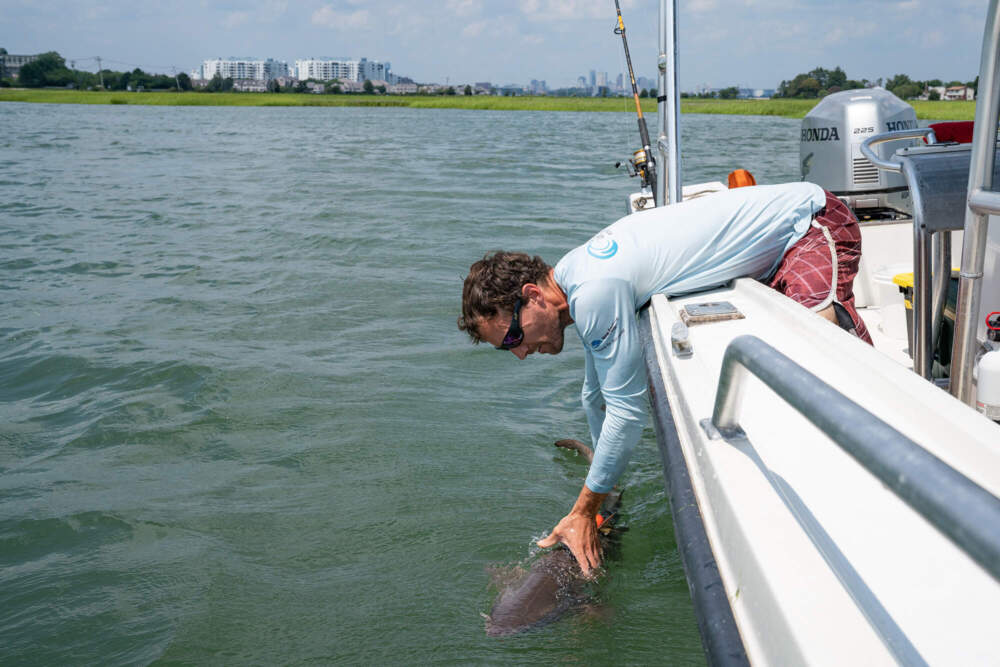Advertisement
Field Guide to Boston
Not just great whites: Your guide to sharks off Massachusetts' coast

Sharks swimming off the Massachusetts coast often conjure a "Jaws"-like image of great whites patrolling the shore. There are white sharks off the coast, to be sure. But they aren't alone: Bay State waters are home to many other shark species as well.
"If all the sharks in the ocean all stood up and jumped out of the water at once, people would probably never go to the beach again because they don't realize there are quite a few sharks out there," said Nick Whitney, a shark researcher and senior scientist at the New England Aquarium.
If you're in the ocean, you're probably swimming with a shark, said Whitney. But that's not automatically a cause for concern. They aren't here to bother people.
Sharks are "incredibly good at not biting us," said Whitney. "We don't give them any credit for that."
There are over a dozen shark species that swim off the coast of Massachusetts, from small dogfish to massive whale sharks. And while white sharks are generally associated with the Cape, research shows they swim all along the coast. But they hang around the Cape because that's where the seals they prey on like to stay.
By contrast, in the Cape Ann and Gloucester area, "we see very few white sharks that visit there. They're actually transient through there," said Greg Skomal, a scientist who studies sharks for the state Division of Marine Fisheries. "So it's more like a highway, whereas Cape Cod is more like a rest stop on the highway."
Sharks even hang out in coastal Boston Harbor. Scientists at the New England Aquarium found a spot just off Wollaston Beach in Quincy where they believe sand tiger sharks come to give birth to pups and juveniles return annually.
"They come back at least for the first couple of years and and use this site in the summer as a little feeding ground and a little safe haven," said Whitney.

Along with white sharks, spiny and smooth dogfish, sand bar sharks, dusky sharks and sand tiger sharks are the species that are most likely to come close the Massachusetts shoreline, said Skomal. Sand sharks are larger than dogfish and and have sharper teeth, but Skomal said they don't pose a real risk to humans.
"They haven't been implicated in any attacks," he said. "The only bites I've seen from the dusky, the sand tiger and the sand bar shark would be if a fisherman mishandles them."
In fact, the biggest sharks to visit Massachusetts waters eat the smallest things. Whale sharks and basking sharks, which can grow up to 40 feet and 30 feet, respectively, are filter feeders.
"They don't eat giant chunks of seal or anything like that the way that you would see like a white shark doing," said Jaida Elcock, a doctoral candidate in the Massachusetts Institute of Technology and Woods Hole Oceanographic Institution joint program who studies the species. "They kind of just filter through the water with their mouths open, collecting whatever zooplankton, like copepods, and things like that [are] in the water."
Advertisement
Whale sharks are also the second known species of omnivorous shark, meaning they eat both animals like tiny zooplankton along with algae, sargassum and other types of phytoplankton, said Elcock.
And if you're worried you could get accidentally swallowed up by the gaping mouths of these filter feeders, Elcock said it's really not possible. "The largest thing they could swallow is probably the size of a grapefruit, so a human is surely not going down that road," she said.
Sharks are generally summer visitors to Massachusetts waters. Only porbeagle sharks, which Skomal called "a cold water cousin of the great white," tend to stay in the frigid waters year round.
But, as climate change causes ocean waters to warm, sharks are on the move. The Gulf of Maine, which extends down from southern Nova Scotia to the eastern most tip of the Cape, is heating up faster than other parts of the ocean. Warmer-waters species like bull sharks and blacktips are being spotted as far north as the New York coast in recent years, said Whitney.
The movement of species will depend heavily on their prey, according to Skomal. White sharks hang around the south shore of the Cape because their prey visits there in big numbers. Skomal said he's interested to see how climate change will impact seals, because shifts in their movement will change where white sharks go as well.
In general, sharks pose little danger to humans, especially if beachgoers respect their space and that of other marine life.
"I think that honestly, one of the biggest dangers to humans is humans not understanding what different wildlife is and feeling free enough to touch it," said Elcock. "There's a lot of stuff in the ocean that's venomous or spiny or whatever the case may be. So, if you see it, that's awesome, you take a picture from a safe distance."
Here are the types of sharks commonly found off the Massachusetts coast right now:
